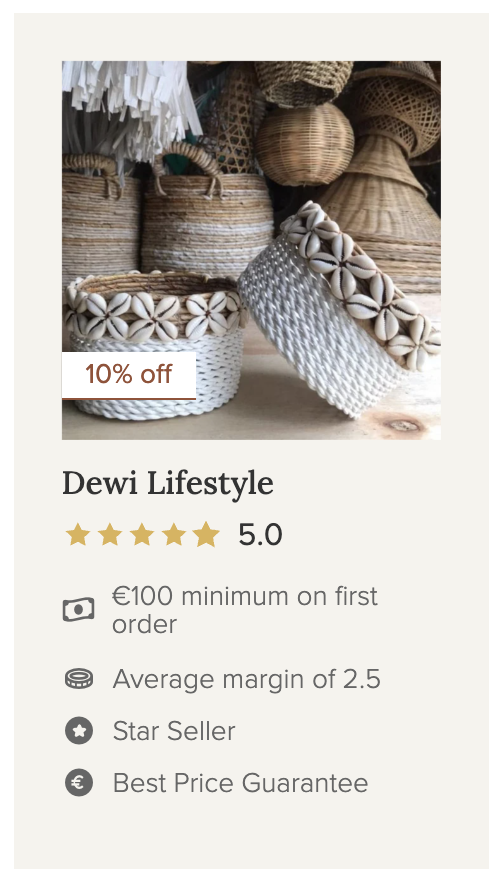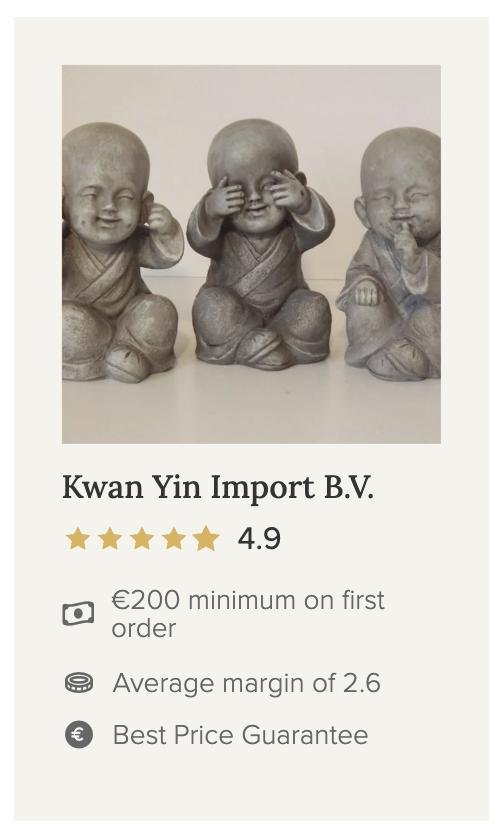What is wholesale?
Wholesaling involves purchasing goods, often in bulk, from manufacturers or distributors at a lower price per unit. The primary goal is to buy products at a discounted rate and resell them at a higher price, thereby making a profit on the margin. Wholesale shopping is particularly beneficial for retailers looking to stock their shelves with a variety of products, businesses aiming to decorate their space, or service providers needing tools and supplies (such as hairdressers or event planners). Wholesale shopping takes place year-round, but buying seasons peak during specific months when businesses are stocking up for the Spring/Summer or Fall/Winter seasons. By purchasing wholesale, retailers can access competitive prices and a wide selection of products, allowing them to meet customer demands efficiently and cost-effectively.
Understanding margins and pricing
Shopping wholesale is very different from shopping B2C. There are different elements and terminologies to keep in mind, such as VAT, wholesale prices, margins, and more. We have listed the main items you should take into consideration:
- Gross margin: This is the difference between the cost of goods sold (COGS) and the revenue generated from sales. A healthy gross margin for retailers typically ranges from 30% to 50%. For example, if you buy a product for €10 and sell it for €20, your gross margin is 50%. Margins are also often expressed as multipliers, such as 1.8 or 2.5. A multiplier of 1.8 means the retail price the retailer will sell an item at is 1.8 times the wholesale price. For instance, if a product’s wholesale price is €10, it will be priced in-store for €18 with a 1.8 multiplier.
- Markup: Markup is the amount added to the cost price of goods to create a profit. It is usually expressed as a percentage of the cost. For example, a product that costs €10 and sells for €20 has a 100% markup.
- Manufacturer's Suggested Retail Price (MSRP): This can also be referred to as recommended retail price (RRP) and is the price at which the manufacturer suggests the product should be sold. While it’s a good benchmark, your final price should also consider your target market, competition, and desired profit margins.




Steps to start wholesale shopping
Looking to buying wholesale for your business but don’t know where to start? Here are some steps that can guide you through this process:
- Research wholesalers: Identify reliable wholesalers who offer quality products at competitive prices. Look for wholesalers with good reputations, positive reviews, and robust supply chains. Consider visiting physical locations to view and touch products, and connect with wholesalers in person. Cash & carry centers are excellent for this, as they are B2B multi-brand shopping centers where you can do all your wholesale shopping in one place. Trade shows are large events where manufacturers and wholesalers temporarily gather in one place showcase their (upcoming) products, providing a great opportunity to discover new suppliers. Visiting showrooms, dedicated spaces where suppliers display their products, can also be highly beneficial. Selecting reliable wholesalers will ultimately help you sell your products and build trust with your customers.

- Evaluate margins: Calculate your potential profit margins by comparing wholesale prices with your intended retail prices. Ensure that the margins are sufficient to cover your costs and generate a profit. There are generally different benchmarks for what a good margin is depending on the product type. Often, items such as fashion and small accessories can have high markups while food & beverage products typically have lower margins.
- Check Minimum Order Values (MOVs): Wholesalers often set Minimum Order Values (MOVs) that you need to meet to place an order. This is because wholesale prices typically include a bulk discount, allowing suppliers to move larger volumes of product efficiently. Ensure you can meet these requirements without overextending your budget. These thresholds can be based on the total order price or on Minimum Order Quantities (MOQs), which specify a minimum number of items you must order from a supplier. Understanding and planning for these requirements will help you manage your finances and inventory effectively.
- Quality control: It’s normal practice to ask a supplier for samples before placing a bigger order. Inspecting samples before committing to large orders is always recommended to ensure you’re getting the best value for your money. Try out the sample to see if the products meet your quality standards and are suitable for your target market.
- Payment terms: Understand the payment terms offered by the wholesaler. Some may offer credit terms, while others require upfront payment. Choose wholesalers whose payment terms align with your cash flow situation.
What to look for in a good wholesaler
Selecting your wholesalers can be overwhelming. You want to find a portfolio of wholesalers that can provide a strong collection for your business, while offering profitable deals and good relationships. Here are a few things to consider:
- Product range: A wide range of products can help you diversify your inventory and meet different customer needs, offering flexibility in meeting purchasing requirements and high profit margins.
- Competitive pricing: Find wholesalers who offer competitive prices without compromising on quality. Oftentimes bigger wholesalers can offer competitive pricing as they get items produced in bulk, lowering their item price.
- Reliability: Choose wholesalers who have a proven track record of delivering orders on time and maintaining consistent product quality. This can save you lots of time and hassle, ensuring a smooth ordering process.
- Customer support: Good customer support can help resolve issues quickly and keep your business running trouble-free. Avoid wholesalers that do not have a direct line of communication, as this too, will save you lots of time.
- Reputation: Check reviews and testimonials from other retailers to gauge the wholesaler’s reliability and quality of service.
Orderchamp’s marketplace streamlines wholesale shopping by centralizing all essential supplier information. At a glance, you can access details on products, margins, minimum order values (MOVs), customer reviews, and more.




Setting retail prices
After you have decided on the items you want to purchase for your business, it’s time to set prices at which these items will be sold at. Of course you can take the manufacturer’s suggested retail price, and sometimes you are contractually obligated to do so, but most of the time this is completely in your hands. We listed a few ways you can determine your pricing:
- Cost-based pricing: Calculate your costs (COGS, shipping, overheads) to determine the minimum profit margin required to keep your business running. From there, you can add your desired profit margin to set the retail price.
- Value-based pricing: Set prices based on the perceived value of the product to your customers. This method often allows for higher pricing if the product is unique or high in demand.
- Competitive pricing: Analyze competitors’ prices and adjust your pricing strategy to remain competitive in the market. With the age of the internet and being able to constantly compare prices, you want to make sure your chosen prices are not much higher than the prices your competitors are offering with the same or similar items.
Conclusion
Wholesale shopping is a way to stock up your retail business or buying items that are needed to offer your services. By understanding key concepts like gross margins, markups, and Manufacturer's Suggested Retail Prices (MSRP), and knowing what to look for in a good wholesaler, you can make informed decisions that drive your business's success. Remember, the right wholesaler will offer competitive prices, reliability, and strong customer support, helping you build a profitable and sustainable retail operation.
Orderchamp simplifies wholesale shopping by centralizing a diverse array of reliable suppliers in one marketplace. Our marketplace makes key information, such as margins and minimum order values, easily accessible to streamline your decision-making process. Additionally, we host various wholesale events, offering opportunities to purchase products at a discount or with exclusive perks, which is typically unavailable in traditional wholesale and can enhance your wholesale shopping experience.
Ready to start wholesale shopping? Explore Orderchamp to connect with reputable wholesalers and shop at competitive prices. Visit Orderchamp to kickstart your business growth today!